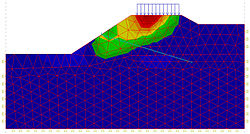Slope Stability

|
| Example of a slope failure. (CTL Engineering) |
Stability of the upstream and downstream slopes of an earth embankment dam is essential to the dam’s safe operation. Unsatisfactory slope performance includes the following categories of slope movement: shear failure, surface sloughing, excessive deformation, liquefaction, and any other types of slope movements [1]. Slope movements that do not cause an immediate failure of the dam can require significant maintenance, and it left unrepaired, can lead to an eventual failure. Proper analysis and design of the embankment slopes, coupled with close monitoring and prompt maintenance or repairs to any moved sections of the slope(s) are key to preventing failure or a major incident from occurring.
“The stability of dams and slopes must be evaluated utilizing pertinent geologic information and information regarding in situ engineering properties of soil and rock materials. The geologic information and site characteristics that should be considered include: (1) groundwater and seepage conditions; (2) lithology, stratigraphy, and geologic details disclosed by borings and geologic interpretations; (3) maximum past overburden at the site as deduced from geologic evidence; (4) structure, including bedding, folding, and faulting; (5) alteration of materials by faulting; (6) joints and joint systems; (7) weathering; (8) cementation; (9) slickensides; (10) field evidence relating to slides, earthquake activity, movement along existing faults, and tension jointing”.[1]
“Evaluation of slope stability requires: (a) establishing the conditions, called ‘design conditions’ or ‘loading conditions,’ to which the slope may be subjected during its life, and (b) performing analyses of stability for each of these conditions. There are four design conditions that must be considered for dams: (1) during and at the end of construction, (2) steady state seepage, (3) sudden drawdown, and (4) earthquake loading. The first three conditions are static; the fourth involves dynamic loading”.[1]
Examples
![]()
Best Practices Resources
![]()
Trainings
![]()
Citations:
Revision ID: 2658
Revision Date: 09/09/2022
